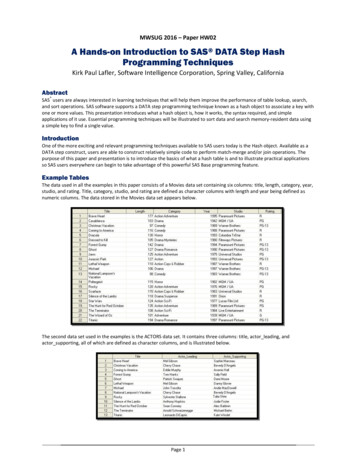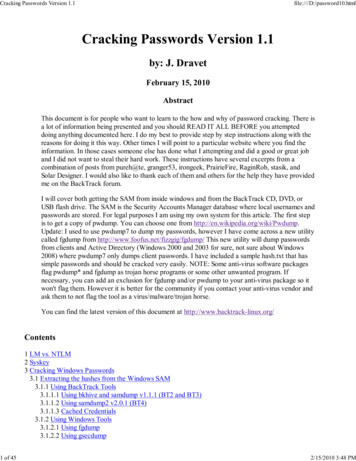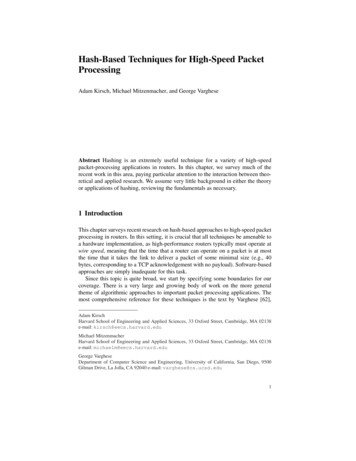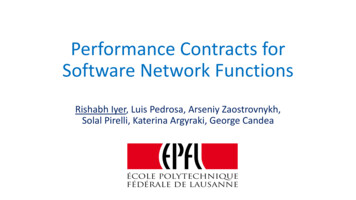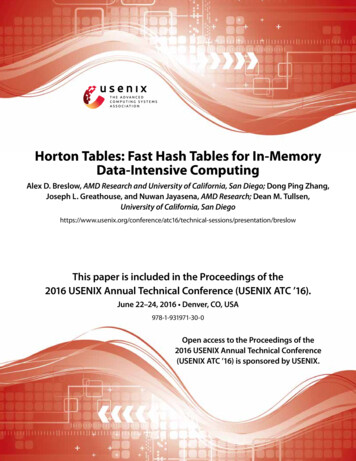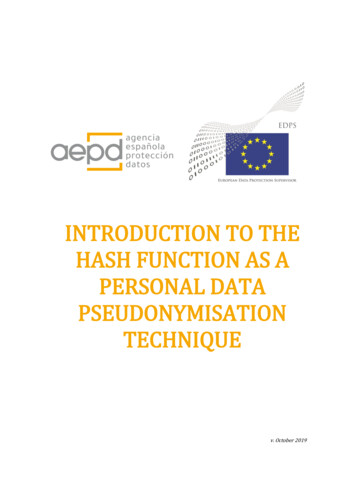
Transcription
INTRODUCTION TO THEHASH FUNCTION AS APERSONAL DATAPSEUDONYMISATIONTECHNIQUEv. October 2019
EXECUTIVE SUMMARYThis essay is intended for data controllers who wish to use hash techniques in theirdata processing activities as a safeguard for personal data pseudonymisation. Thefundamentals and properties of hash techniques are presented throughout the text.Application of such techniques may sometimes entail a high risk of identifying themessage generating the hash. This document analyses the sources of risk of reidentification in application of hash techniques, and establishes the need to carry outan objective analysis of this risk in order to determine whether this pseudonymisationor even anonymisation technique is appropriate. This analysis involves both theprocess followed and any other elements that form the hash systems, paying specialattention to message entropy and to information linked or linkable to the valuerepresented by the hash.Page 2 of 31
CONTENTSI.INTRODUCTION AND PURPOSE5II. DIGEST OR HASH FUNCTION5Desirable properties in a hash function7Description of a hash function7III.8HASH AS AN UNIQUE IDENTIFIERAnalysis based on a specific processing.IV.THE REIDENTIFICATION PROBLEM910Playing a hash over telephone numbers10Processing analysis11Reidentification analysis12Order, disorder and information12V.LINKING INFORMATION TO A HASH13Identifiers linked to a hash13Pseudoidentifiers linked to a hash13Links to other type of information14VI.STRATEGIES TO HINDER REIDENTIFICATION14Key reuse encryption15Adding a message heading or reusable salt models17Single-use salt models18Differential models20VII. HASH ANALYSIS AS A SYSTEM OF PSEUDOMINISATION OR ANONIMISATIONFOR PERSONAL DATA21Page 3 of 31
VIII. CONCLUSIONS22IX.23X.REFERENCESANNEXESERROR! BOOKMARK NOT DEFINED.GDPR Extracts24Extracts of Opinion 5/2014 on anonymisation techniques26Extracts of the AEPD Guidelines and Guarantees for Personal Data Anonymisation Procedures27Extracts of the ENISA document28Page 4 of 31
I.INTRODUCTION AND PURPOSECurrently, the value of data is indisputable. Data have become a key factor forscientific research, public administration and an ever-growing digital economy.Development of promising technologies such as Big Data or Machine Learning greatlydepends on being fed a large quantity of data.This increasing demand for personal data has entailed a renewed interest inanonymisation techniques and processes. Hash functions have been used for a longtime in order to provide an additional protection when processing personal data.However, there is doubt regarding to what extent hash functions constitute an efficientpseudonymisation technique, as well as whether, under certain circumstances, such asthe original message having been deleted, the hash value may be even considered asanonymised1.This decision is of paramount importance to determine, among other things,effective compliance of the rights recognised by the GDPR in certain types ofprocessing, such as research, traffic data analysis or geolocation, blockchain andothers. Legal, technical and process management considerations are factored in whenmaking the appropriate decision and, therefore, those involved in making this decisionmay need to have a basic knowledge of hash techniques and their potential risks.This essay is addressed to data controllers who wish to use implementations basedon the use of hash functions in order to pseudonymise or anonymise personal data. Itbriefly presents the basic aspects of hash functions, their properties and the possibilityto re-identify the message generated by the hash, while also establishing certainguidelines to analyse the suitability of hash function-based processing.II.DIGEST OR HASH FUNCTIONA digest or hash function is a process which transforms any random dataset in afixed length character series, regardless of the size of input data.The output is called hash value or code, digest, image or hash. Often, the term “hash”is used both in reference to the hash function as to the hash value, which is the outputof playing this function on a particular message. The data that are to be run throughthe hash function are called the message or preimage. The set formed by all possiblemessages or preimages is the message domain or message space.For example, if the hash function SHA2562 is used to determine the hash value for“Hello” the output shall be the following digest:SHA256(Hello) 47870934644989980731601655193Blockchain and the General Data Protection /es/document.html?reference EPRS STU%282019%296344452 You can find a hash functions similator at https://hash.online-convert.com/3 Hexadecimal notation is normally used since there is a direct correspondence between digits and underlying bits, which would be lostif decimal notation was used. The information above in hexadecimal notation 15BA60B5D76B0E88F1Page 5 of 31
In this example, “Hello” is translated into a set of bits, from which, after a series ofoperations4, a 256-bit string is obtained (here represented by its value in decimalnotation).However, when a more complex message, for example, a pdf file containing the fulltext of the Quixote (471 pages), is run through a hash function, the output of the hashfunction will be different, but the output will be a digest with the same size in bits asthe previous one:SHA256 ( PDF file containing unabridged edition of the Quixote ) 9199473103013809356525721695The first message, “Hello” used 32 bits6; however, the second message, theunabridged edition of the Quixote, consisted of a document whose size exceeded 8million bits. Therefore, the hash function may be represented in the following way:To the left, the message space is represented, that is, all possible datasets which maybe created and from which a hash may be generated. In this figure, this set isrepresented with blurred limits, since this space may be infinite, given that it is alwayspossible to create a larger message.To the right of the image, the hash space is represented as a box of smaller size anddefined limits. The size of the hash space depends on the number of bits used in thehash outlet. Taking SHA-256 as an example, the outputs of this hash have a size of 256bits, but depending on the corresponding algorithm may be of any size; the mostcommon are 32 to 512 bits. In order to have an idea of how many different hash valuesmay be obtained with a hash size of 256 bits, the total number shall exceed the resultobtained by multiplying one million by one million thirteen times7.Hexadecimal notation extended representation of numbers beyond the common 0-9 notation to include 10 (A) 11 (B) 12 (C) 13 (D) 14(E) y 15 (F). Consequently, numbers are represented by digits 0 to F. Its advantage lies in the fact that a single digit may represent 4bits. Such 4 bits may present 16 different combinations.4 A very clear description of this process may be found at a-256-4c2afc191c405 9199473103013809356525721696 In ASCII code7 In order to calculate the approximate value of a dataset it may be considered that only 10 bits are needed to code 1024 statuses;therefore, 20 bits yield over one million statuses (1024x1024). As for 256, when divided by 20, the result obtained is 13.Page 6 of 31
DESIRABLE PROPERTIES IN A HASH FUNCTIONThe optimal properties of a hash function are: It may be played on digital contents of any size and format: at the end of theday, for a computer, all types of digital content (text, images, videos, etc.) arenumbers. Any given input may produce a fixed size numerical output. This output is deterministic, that is; the same input message or datasetalways yields the same output. Reconstructing the original input from the hash function output must beextremely difficult, if not outright impossible. A minimum variation in the original message (one bit) must yield acompletely different hash (diffusion). Taking an input message, finding another message with the same digest mustbe extremely difficult (weak collision). Finding any two messages that yield the same summary must be alsoextremely difficult (strong collision). The hash algorithm must cover the entire hash space uniformly, which meansthat any output of a hash function has, in principle, the same probability ofoccurrence as any other. Therefore, all values in the hash space may be anoutput of the hash function.DESCRIPTION OF A HASH FUNCTIONIn general, hash functions work as follows: The input message is divided into blocks. Then the hash for the first block, a value with a fixed size, is calculated for thefirst block. Then, the hash for the second block is obtained and added to the previousoutput. This process is repeated until all blocks are calculated.A very simple example of a hash function is briefly described below. Our first task isto design a hash function that, from a text, generates a three digit decimal hash (000 to999). The message used to calculate the hash shall be the first lines of the Quixote ( Insome village in La Mancha, whose name I do not care to recall, there dwelt not so longago a gentleman of the type wont to keep an unused lance, etc.). In Spanish:En un lugar de la Mancha de cuyo nombre no quiero acordarme no ha muchotiempo que vivía un hidalgo de los de lanza en astillero, etc.In the first stage, the above text would be divided into blocks of (for the purpose ofthis example) twenty characters. In this manner, in the following table each rowrepresents one mír8uruad mama17abrple18rmogn19Mee20AqoaPage 7 of 31
The next step would be to assign a numerical value to each character, for example:A-1; B-2; C-3; etc., finishing with zero for a space. Consequently, the following codingwould be obtained for the first 121711801913201The hash value can be obtained in multiple ways, for example, by multiplying thevalue assigned to a character with its position within the block8 and then addingtogether all results. For this particular block, the final output would be 1331. As theoutput of this hash function must have only three decimal digits, the output may bedirectly truncated removing any digits above the third. Therefore, the hash output forthe first block would be 331.Next, the following row or block would 721819195200If the same hash function were played over the same block, the output would be1947, which, once truncated above the third digit, would be 947.Subsequently, the two blocks would be linked by means of adding the results of bothblocks, 331 947 1278, a hash value for the first two blocks that is again truncatedto 278. This process would be repeated with all rows or blocks until obtaining the finaloutput.The system presented here does not show good properties as a hash function: thehash value is too short (there are only 1000 possible outputs), it is possible to alter thetext and maintain the hash9, implementation is not efficient, etc. For this reason, othertypes of more appropriate hash functions have been developed, such as the SHA10, theMD511 family or others12.III.HASH AS AN UNIQUE IDENTIFIERThe number of possible outputs of a hash function is very high, but is not infinite.Since the message space may be infinite, there are infinite messages that may yield thesame hash value. The message set which yield the same hash value as the outcome iscalled the preimage set.This prevents obtaining the same hash when the same letters are moved around within a text, as if replacing “En un lugar de laMa ” by “De un lugar en la Ma ”.9 The letter with a value of 5 in position 6 gives the same result as the letter with value 6 in position 5. Using weighing such as primefactors would prevent using these equivalences.10 FIPS PUB 180-4 Secure Hash Standard (SHS) https://ws680.nist.gov/publication/get pdf.cfm?pub id 91097711 RFC1321 The MD5 Message-Digest Algorithm https://www.ietf.org/rfc/rfc1321.txt12 https://en.wikipedia.org/wiki/List of hash functions8Page 8 of 31
The existence of sets of preimages, which may cast a doubt over the usefulness ofthe hash function as a unique identifier, is considered exclusively in a theoreticalenvironment and not for a specific processing operation.ANALYSIS BASED ON A SPECIFIC PROCESSING OPERATION.Let us consider that a processing activity intends to associate a hash value to eachbook that has been ever published worldwide, based on their digitalised contents. Afew years ago, Google reported that the number of books published worldwide was130 million13.This figure is significantly lower than the number of possible hash results for afunction such as SHA-256. Even multiplying the total number of books by 7,000, theresult of which would exceed one million million, we would be very far from saturatingthe hash value space.In a graphic representation, the set of all edited books is a subset of all possiblemessages, and a sufficiently small subset, so that preimages of, for example, theQuixote, are left -of-world-stand-up-and-be-counted.htmlPage 9 of 31
The shadowed area over the hash spaces represents the set of hash values thatwould be generated by obtaining the hash for all edited books. This set would representa tiny part of the set of possible hash values.Although the number of edited books is high, if the square corresponding to thisnumber were to be drawn in the figure above at the same scale as the squarecorresponding to the hash space, the first would be so tiny that it would be practicallyinvisible.The difference between the set of edited books and any other possible messages thatmay constitute a preimage of the Quixote lays in the concept of “order”. Books are notformed by just any combination of letters, but by words in a specific language, whichare structured according to the rules of specific grammar, following a narrativestructure and yielding a meaningful message. Therefore, if the same hashcorresponded to a specific book and to a meaningless message, the former would bediscarded as not belonging to our effective message space, i.e. not belonging to ourprocessing operation.The stricter this “order” is (for example, in the case that only books in Spanish andnot in any other language were admitted), the smaller the set of books (processingmessage space) will be and the less likely a collision will be.However, there is no guarantee that two hash values corresponding to two differentbooks do not match, although the possibility is negligible in a well-built algorithm. Thislikelihood may be determined through analysis by a generalisation of the birthdayparadox14. For this reason, if within the hash space a square is set that contains allhashes corresponding to the real message space, the limits of this square will beblurred; that is, if there are a million million edited books and the hashes for all of themare obtained, it is highly probable -though not guaranteed - that a million milliondifferent hashes will be generated. However, for practical purposes, there is a biunivocal, i.e. 1 to 1 correspondence between books and hashes.IV.THE REIDENTIFICATION PROBLEMHash functions aim to be irreversible (please see section on Desirable properties ina hash function) and therefore the result of applying a hash function to a directidentifier should prevent the re-identification of this direct identifier. In spite of theabove, the same “order” implicit in any processing activity, and which guarantees thehash effectivity as a single identifier, also increases the likelihood of identifying theoriginal message from the hash.PLAYING A HASH OVER TELEPHONE NUMBERSAs an example, let us consider that as part of a processing operation, the hash of amobile telephone number of a telecommunications company is assessed. Theprocessing designer uses a hash function that generates a hash value with a size of 64bits15.A telephone number is formed of 9 digits, plus two digits corresponding to theregional code and preceded by the “ ” symbol, totalling 12 symbols. If each symbol isstored in a byte, the total number of bits is: 12 x 8 96 bits.1415https://en.wikipedia.org/wiki/Birthday problem#GeneralizationsFor example, Cityhash https://github.com/google/cityhashPage 10 of 31
In the above figure, it is easy to see how the telephone number space is larger thanthe hash space. If all possible hashes for all possible 96 bits combinations were to becalculated, the entire hash space would inevitably be covered, and more than fourthousand collisions would occur. In principle, the hash function would have tocompress the 96 bits of the number into the 64 bits of the hash.On one hand, if the 96 bits of the number included information, converting thisnumber to a 64-bit hash would necessarily imply losing information and would makethe hash irreversible. On the other hand, it is possible to consider whether thisprocessing design complies with the requirement of having a univocal identifier.PROCESSING ANALYSISA more detailed analysis would provide an answer to these questions.16 On one hand, eleven of the digits are numerical, which yield 100,000 millioncombinations. If we consider that a keyboard only includes 20 possiblesymbols, the coding of an additional symbol in order to register the initial “ ”would increase the number of combinations to 2 billion16. This may seem afairly large figure, but, translated into bits, the amount of data has beenreduced from 96 bits to approximately 41 bits. This is far below the 96 initialbits and also below 64 bits, i.e. the hash size. Therefore, it would be useful asa single identifier. Since the processing framework supposes that all numbers correspond toSpanish subscribers, it is known they all have the prefix 34. Therefore,these data are fixed. The other 9 digits yield one thousand millioncombinations (approximately 30 bits). If the telephone numbers to be processed are Spanish mobile phonenumbers, they will begin with 6 or 7. Therefore, since the first number isfixed, there are only 200 million combinations (approximately 28 bits). However, there are not 200 million telephone subscribers in Spain. Thecurrent number of mobile lines does not even reach 60 million. The operator with the highest number of mobiles does not reach 20 million(20 bits of information). Therefore, if the mobile operator to which thetelephone number hash corresponds is known, and access to the telephonelist is granted, the number of combinations decreases greatly, and actualA billion here means a million millions.Page 11 of 31
information contained by the original 96 bits of data are only 20 bits ofinformation.By way of an example, the definition of processing implicitly includes an order thatlimits the set of possible messages in the framework of this treatment (its messagespace). The number of possible valid messages (220) is much lower than the number ofpossible hashes (264). The possibility of collision is therefore very low17 and the hashwould practically serve as a single identifier.RE-IDENTIFICATION ANALYSISWith regard to the possibility that, from a given hash, it is possible to find out whichnumber it corresponds to, keeping in mind that a desktop computer is capable ofcalculating over 1 million hashes per second it is possible to create a directory for allpossible hashes for the telephone numbers of a given operator in less than 20 seconds,i.e. with practically no delay at all18. That is, the information referenced by the hashmay be recovered.In this case, the amount of information was small, but even for much larger messagespaces, holding more information, there are techniques known as Rainbow Tables19that allow for the reversal of a hash.ORDER, DISORDER AND INFORMATIONWhen the data used in a processing operation have an implicit order, the set ofpossible messages (message space) is greatly reduced, which makes message reversal(i.e. re-identification) easier.The stricter the implicit order in a dataset, the more fixed a message is, and the lessreal information it contains. Knowledge is obtained from the data structure itself (e.g.Spanish mobile telephone numbers start either with 346 or 347) or from theprocessing environment (e.g. the telephone numbers managed by the operator areknown). For these reasons, it is necessary to distinguish between the data in a message17Very low but not zero. If analysed as a memory-less system, the likelihood of two or more hashes matching, with 20 millionoccurrences as in this case, would be calculated as follows: P 1- [264! / ((264*20.000.000)*(264-20.000.000)!)]. Due to the complexity ofcalculating large numbers, it may be guaranteed that such likelihood is well below 0.002%.18 ha-512-speed-performance/19 Rainbow Tables attack: Data attack method which uses a pre-computed table of hash chains(Fixed length message digests) in order to identify the original data source. CCN-STIC 401Page 12 of 31
(96 bits in the above example) and the information included in this data (20 bits in theabove example).The degree of order or disorder in a dataset is called entropy20. The higher theentropy, the more information a data set contains. On the contrary, a lower disorderlevel (entropy) involves the existence of fewer alternatives, and therefore the samedata will contain less information.The smaller the message space and the lower the entropy are, the lower the risk ofcollision in hash processing is, but re-identification will be more likely. On the contrary,the higher the entropy, the higher the possibility of a collision, but the risk of reidentification will be lower.Measuring the amount of information, which is very different from the number ofbits used to record a message, is one of the most important analyses that needs to becarried out every time that a message needs to be protected, either by means of hashfunctions or by using any other techniques, such as encryption, and requires anaccurate analysis21.V.LINKING INFORMATION TO A HASHIn the previous example, the more information that was available about thepotential message space (its structure, the geographical location of users, theirtelephone operator), the higher the implicit “order” of the message was and the lessinformation was included in the hash itself, which made reidentification more likely.IDENTIFIERS LINKED TO A HASHA file with personal data may include “identifiers” which are, by their own means,univocally associated to a data holder (e.g. a person’s full name, ID document orpassport number).When there are identifiers linked to a hash, for example, when an ID number and ahash corresponding to a telephone number linked to that ID are stored, it is obviousthat the information belongs to a certain data holder. With regard to the confidentialityof information represented in the hash, the fact of having a linked identifier adds anadditional vulnerability to the existing weakness of the relevant hash, since, from thatID number, information may be obtained which reduces the effective message spacefor that particular hash.That is, the more personal information that is linked to the hash, the higher the riskof identifying the contents of this hash.PSEUDOIDENTIFIERS LINKED TO A HASHFiles with personal data may also include other data which, when convenientlybundled and crossed with other information sources, may result in the successfulidentification of an individual. Such data are called “pseudoidentifiers”, “quasiEntropy is a principle of thermodynamics which establishes that a system’s disorder only increases over time. In order to see anexample of its relationship with information, let us imagine a freshly painted, perfectly white wall, which could be described in a fewwords: “three metres tall, five metres long, pure white”. As time goes by, some areas become greyish, cracks and stains appear, etc.That is, its entropy increases. At this stage, the wall cannot be described in a few words; a lengthy description is needed to record allits flaws. Therefore, there is more information.21 An analysis of the information linked to processing may be carried out by analysing entropy, identifying the set of all possiblestatuses x(i) and its associate probability P(xi) by calculating: Information - Σ (1.n) P(xi) log2 P(xi)20Page 13 of 31
identifiers” or indirect identifiers22. The relationship between these and the hash valuecan be established in two ways.The first one is that the hash may be linked to pseudoidentifiers as a secondary effectthat is not the purpose of the processing. The second case occurs when the purpose ofthe processing operation is to link pseudoidentifiers to one another by means of a hashvalue.In one way or another, the information provided by these pseudoidentifiersdecreases the efficiency of hash functions by providing hints on the informationcontained in the hash value, which may allow for the identification of the data holder.The risk of re-identification will depend not only on the type of pseudoidentifiers butalso on the correct application of randomisation or generalisation techniques23 onindirect identifiers. In order to determine the extent to which this set of information isanonymous, it would be necessary to make an analysis of k-anonymity, for example24.LINKS TO OTHER TYPES OF INFORMATIONThere might be an additional factor that arises when the theoretical design of aprocessing operation manifests itself implemented in an IT system and a series ofworking procedures. The actual operation may create circumstances which allow forthe linking of additional information to a hash, and which were not provided in theoriginal processing plan, such as: The relative position of the hash in a table or data chain allows for theestablishment of relationships between information stored previously or ata later date. The hash record date in the corresponding table allows for the linking of thishash with information included in other tables or chains completed on thesame date. In the same way, log files associated with transmission, use of computingservices, access to storing systems, etc., are information sources that allowfor data crossing.All such possibilities must be factored in for the purpose of determining the hash reidentification risk level.VI.STRATEGIES TO HINDER REIDENTIFICATIONAEPD: K-anonymity as a privacy measure.WP29: Opinion 05/2014 on anonymisation techniques.24 AEPD: K-anonymity as a privacy measure.2223Page 14 of 31
KEY REUSE ENCRYPTIONA strategy to hinder re-identification of the hash value is to use an encryptionalgorithm25 with a key that is confidentially stored by the data controller or with theother person taking part in the processing, so that the message is properly encryptedbefore the hash is completed. Alternatively, the hash is encrypted once it is computed.The encryption process yields a new message (encrypted text) from the original (plaintext). There is an efficient process to obtain one from the other by using keys.Both strategies are shown in the figure below:As shown in the figure above, encryption achieves a kind of correspondencebetween different message spaces, in the first instance, or, when the hash itself isencrypted, between two hash spaces.The encryption process, unlike the hash computing process, is an inherentlyreversible process, which, by its own nature, keeps the encrypted information. That is,information is right there, it does not increase or decrease with the encryption processand the encrypted and non-encrypted spaces are linked by the key.In this case, we ca show the connection between message spaces and encryptedspaces (cryptogram) for a key in the following manner:25Whether the encryption system is symmetrical or asymmetrical is indifferent.Page 15 of 31
In the figure, the point between the two spaces represents the same message,unencrypted at the left and encrypted to the right.When the key is not known, the only reference for an observer would be that thereis an encrypted message, and that this message may correspond to almost as many keysas may be thought up.However, if there are several encrypted texts from different messages, at some pointall they may only correspond to a single space of cryptograms, which may be generatedby a single key:This principle is known under the name of Unicity Distance26 and it establishes that,over a given threshold of encrypted text, both the plain text and the key are determined.This entails that, even though the key may be deleted by the data controller, the key isimplicit in the encrypted text, so that neither the key nor the information it protectsmay disappear, and, therefore, they may both be recovered27.Established by Shannon in the report “Communication Theory of Secrecy Systems”, explained in the following terms: depending onthe entropy of the encryption systems, the length of the message based on which, given a specific cryptogram and encryptionalgorithm, both the key and the plain message are entirely determined.27 This distance may be very short, if Unicity Distance Log2(nº claves) / Redundancy Log2(nº keys) / (log2(symbols)-entropy) for atext in Spanish encrypted by means of AES256 unicity distance equals log2(2256)/(log2(27)-2) that is, approximately 95 characters. Thatis, a single 100-character encrypted text exceeds such distance.26Page 16 of 31
Re-identification will therefore be protected by a set level of certainty that willdepend on the weaknesses inherent to any encryption system: Compromise of key confidentiality. Working in distributed e
This essay is intended for data controllers who wish to use hash techniques in their data processing activities as a safeguard for personal data pseudonymisation. . for example, a pdf file containing the full text of the Quixote (471 pages), is run through a hash function, the output of the hash function will be different, but the output will .



